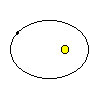
graphic from: http://www.museum.state.il.us/exhibits/ice_ages
The Milankovitch Theory—Earth’s Climate through Time
Beth Caissie, Physics 212
April 16, 2003
 |
In the nineteen-teens, as World War I raged across Europe, Milutin Milankovic, a Serbian astronomer and prisoner of war, was busy computing the gravitational force of planets like Jupiter on the Earth’s tilt and orbit. He had an idea that the amount of solar radiation that reaches higher latitudes could trigger an ice age or warm up the Earth. He believed that slow changes in the Earth’s orbit contributed to the amount of solar radiation reaching a particular latitude. By the end of the war, his first paper was published on the subject, and he began to expand upon his initial ideas. In 1941, he published Canon of Insolation of the Earth and Its Application to the Problem of the Ice Ages, describing his theories about the Earth’s orbit and tilt which are now referred to as the Milankovitch Cycles. |
graphic from: http://www.museum.state.il.us/exhibits/ice_ages |
|
 |
image from www.ghmskola.edu.yu |
 |
 |
 |
 |
 |
 |